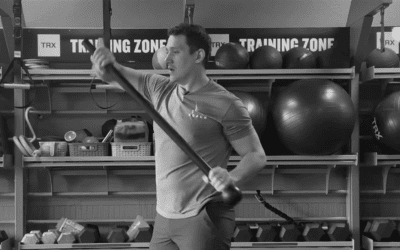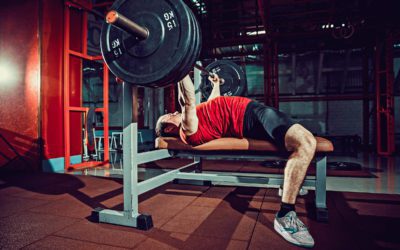CrossFit Open Preparation: Training Your Way to the Top

Written By
Todd Nief
Todd Nief is the Owner and Director of Training at South Loop Strength and Conditioning. He blogs regularly on all things strength and conditioning at southloopsc.com.
Even though the Open consists of unknown events, we can make some pretty good guesses at types of workouts and what movements will appear, and, as such, we can make some recommendations to best prepare. At this point, the work has been put in to develop as much strength and aerobic capacity as possible, and now the goal is to learn to apply it to mixed modal testers.
While it is certainly possible that the Open this year will look quite different than past years, we now have three years of data to guess at what types of workouts will appear:
- 5 to 20-minute couplets and triplets with light to moderate loads
- Movements that can be done with a barbell, a pull-up bar, a box, a medicine ball, and a set of rings
- Movements that are easy to judge
- Workouts that are easy to perform in a garage gym

We may see some significant variation this year given the new requirement that top individual competitors film all their workouts. This may allow for more variation in the movements selected and the types of workouts performed, as the video requirement reduces the likelihood that someone will make it through the Open due to suspect standards and lax judging. It’s certainly feasible that we may see some other movements that may have been excluded in the past due to potential judging foibles: handstand push-ups, pistols, and heavy squatting movements.
Also, the introduction of the “choose your starting weight ladder” at last year’s Regionals (overhead squat event) and Games (clean & jerk event) may make an appearance in the Open as well, allowing for a feasible way to truly test strength in the Open format.
Still, while these are possibilities, my assumption is that the Open will still look a lot like previous year’s Opens. As such, here’s my thoughts on how to peak (which will, of course, be used to peak the Advanced Fitness Competitor program). Ideally, every competitor would have an individualized program that would cater to their specific needs and goals, as well as their individual tolerance to training volume. However, this is not reality for everyone, so here are some principles that will apply to the majority of athletes looking to be competitive in the Open.
GET REALLY GOOD AT 7 TO 20 MINUTE COUPLETS AND TRIPLETS
Expect there to be one or two workouts involving two or three high turnover, moderate skill movements that will be able to be done nearly unbroken by top competitors. Expect there to be a moderately loaded barbell movement, and a bodyweight focused conditioning movement. In these workouts, things like cycle time of reps and transition time between exercises will matter. Top athletes will be able to consciously move fast and separate themselves from the field. Middle of the pack folks will need to develop an understanding of their engine so that they can move as fast as possible without “redlining” and bombing the last half of the workout. In addition to peaking the lactate endurance system (discussed shortly), simply practicing this type of workout to understand how to pace transition times and rep cycle times is essential.
Previous Open Workout Examples:
11.1
10 min AMRAP:
- 30 double-unders
- 15 power snatches (75/55)
12.3
18 min AMRAP:
- 15 box jumps (24/20)
- 12 shoulder-to-overhead (115/75)
- 9 toes-to-bar
13.2
10 min AMRAP:
- 5 shoulder-to-overhead (115/75)
- 10 deadlifts (115/75)
- 15 box jumps (24/20)
GET REALLY GOOD AT CHIPPERS WITH A BIG SET OF MUSCLE-UPS AT THE END OR HEAVY OLYMPIC LIFTS AT THE END
Given that the Open is intended to be inclusive, we are unlikely to see a movement like a muscle-up appear in a standard couplet or triplet. Rather, higher skill movements and heavier weights are likely to appear after a large chunk of work that almost everyone is going to be able to do. Top competitors are not only able to move through a chipper piece quickly, but they can do so without hitting failure, and can then perform higher skill or heavy movements under mechanical and metabolic fatigue. This is a reflection of aerobic fitness as well as the CP battery. While it is relevant to include testers of this variety to practice the pace and understand the feel, the CP battery should be trained in targeted sessions. There are a variety of ways to do this, but, as the Open approaches, adding in more fatigue to the training sessions is relevant. It is also relevant to practice changing plates during workouts, as weights increasing during an Open workout has appeared in the last two years.
Examples of Open Workouts:
11.4
10 min AMRAP:
- 60 bar-facing burpees
- 30 overhead sqauts (120/90)
- 10 muscle-ups
13.1
18 min AMRAP:
- 40 burpees, 6″ jump
- 30 snatches (75/45)
- 30 burpees, 6″ jump
- 30 snatches (135/75)
- 20 burpees, 6″ jump
- 30 snatches (165/100)
- 10 burpees, 6″ jump
- AMRAP snatches (210/120)
12.3
12 min AMRAP:
- 150 wall balls (20/14)
- 90 double-unders
- 30 muscle-ups
Examples of fatigue-based CP battery training
7 min AMRAP:
Double-unders
+
7 min AMRAP:
Burpee muscle-ups
*No rest between AMRAPs
For time:
- 10 squat snatches (135/95)
- 10 muscle-ups
- 8 squat snatches (155/105)
- 10 muscle-ups
- 6 squat snatches (175/115)
- 10 muscle-ups
- 4 squat snatches (195/125)
PEAK THE LACTATE ENDURANCE SYSTEM
The Open will be quite uncomfortable for nearly everyone participating. These workouts will demand that most participants dig deep into sugar-burning energy production, and top competitors will be able to keep moving while their body overheats and fills with metabolic waste. This is a quality that can be trained. While this type of training is potentially draining on the CNS and can blunt gains in aerobic and strength adaptation, it is crucial to succeed in high turnover conditioning pieces. A detailed discussion of program design relative to this peak is beyond the scope of this article, but more information can be found in this article: “Effectively Training the Lactate Endurance System” from Train Heroic.
A properly peaked anaerobic lactate system is what enables an athlete to grind through the last five minutes of a miserable workout and have something left in the tank to kick for the last minute. These lactate training sessions should occur twice per week and progress in timeframe from shorter (20-40s) to longer (3 min+) as the Open nears. Once the timeframe allows, training sessions should be split between mixed modal and cyclical. The mixed modal pieces require more of a CNS demand for this system, while the cyclical pieces allow for a more cellular and metabolic adaptation (as such, the cyclical pieces are often more uncomfortable than the mixed pieces).
IMPROVE SKILL ON ANY LACKING MOVEMENTS
There are a few skill-based movements that will almost certainly appear in the Open. If your technique or mechanics on any of these movements is lacking, getting it up to par is imperative. Ideally, this would have been occurring over the last year, but significant progress can still be made over the next month. These movements are: double-unders, rebounding box jumps (be aware that there is a potential for serious Achilles injury on this movement), ring muscle-ups, chest-to-bar pull-ups, toes-to-bar and power snatches. If you significantly struggle with any of these movements, seek out a good coach to work technique. Also, if mobility or motor control is a problem, it may be necessary to work with a good massage therapist or physical therapist to improve your movement patterns. Lastly, practice regularly in non-fatigue based settings. Warm-ups and cool downs are great, but, ideally, your training would include a few sessions per week of restorative, play-like pieces in which you can insert movements you struggle with in order to develop skills.
REPEATING CROSSFIT OPEN WORKOUTS
There is always controversy regarding the repeating of Open workouts. The reality is that only the very top percentage of CrossFit athletes know they’re going to make it through the Open onto the Regional level. As the numbers of participants and the overall skill of the participants increases, a single bad workout can certainly bump a perennial contender to just missing qualification. For anyone who takes the sport seriously and intends to compete at the Regional level, I definitely recommend planning to do the Open workout twice in the weekly training template.
If you’re satisfied with your score the first time or if the volume of the workout presents an injury risk, then you don’t have to do the workout again. However, almost everyone competing at a high level will improve their score by a handful of reps on their second attempt. This does truly matter, especially for “middle of the pack” competitors, where a few reps here and a few reps there can easily make the difference between 48th and 70th place in the region.
TEMPLATE FOR CROSSFIT GAMES OPEN PREPARATIONS
If your goal and priority in training is to truly do well in the Open, this must be a year-round training effort. Starting when this year’s Open ends until next winter, you must be training to develop your strength, aerobic capacity & skill as much as possible so that a peaking template can effectively get you in game shape. The best peaking template in the world won’t help you if you don’t have the baseline conditioning and strength to complete the workouts.
The best way to do this is to hire an individual coach to assess your strengths and weaknesses and design an appropriate program. If this is not feasible, you can follow one of the many free training programs online, or, better yet, you can sign up for our Fitness Competitor program at www.coach.trainheroic.com to train, track, and compete with me year round. You can use the information on this site to choose one that makes sense for your goals.
If you’re satisfied with your score the first time or if the volume of the workout presents an injury risk, then you don’t have to do the workout again. However, almost everyone competing at a high level will improve their score by a handful of reps on their second attempt. This does truly matter, especially for “middle of the pack” competitors, where a few reps here and a few reps there can easily make the difference between 48th and 70th place in the region.
Find Your Perfect Training Plan
Sometimes all you need to reach your destination on your fitness journey is an expert guide. Look no further, we've got you covered. Browse from thousands of programs for any goal and every type of athlete.
Try any programming subscription FREE for 7 days!
Related Articles
You May Also Like...
The Ultimate Guide to Lunges: Queen of all Glute Exercises
Your glutes are the largest muscle group in your body. They’re responsible for almost everything your legs do—walking, running, jumping, squatting, lunging, and just standing upright. As far as moving through space goes, strong glutes are the bedrock of overall...
A Beginner’s Guide to Steel Mace Training
Think you’ve mastered kettlebells? Meet the steel mace — the brutal, offset weapon that forces your body into three-dimensional stability, grip work, and rotational strength. Ancient tool. Modern performance.Written Byjesse grund Jesse Grund’s passion is simple: coach...
The Best Bench Press Warm Up Strategy
We get it. You’re pressed for time in the gym. But skipping the warm up is the surest way to underperform and risk injury. This 3D approach to your bench press warm up not only allows you to lift more weight, but also ensures the long-term health of your shoulder...
The Ultimate Guide to Lunges: Queen of all Glute Exercises
Your glutes are the largest muscle group in your body. They’re responsible for almost everything your legs do—walking, running, jumping, squatting, lunging, and just standing upright. As far as moving through space goes, strong glutes are the bedrock of overall...
A Beginner’s Guide to Steel Mace Training
Author: Jesse Grund
Mace training will make you a better mover without it’s not confining you to a fixed space or predetermined range of motion. Second, it’s an offset load with 80 to 90 percent of the weight in the head. You’re also constantly having to resist rotation, which creates greater core engagement.

Want more training content?
Subscribe
For Coaches
For Athletes
About
Support
Training Lab
Access the latest articles, reviews, and case studies from the top strength and conditioning minds in the TH Training Lab!
Made with love, sweat, protein isolate and hard work in Denver, CO
© 2024 TrainHeroic, Inc. All rights reserved.





